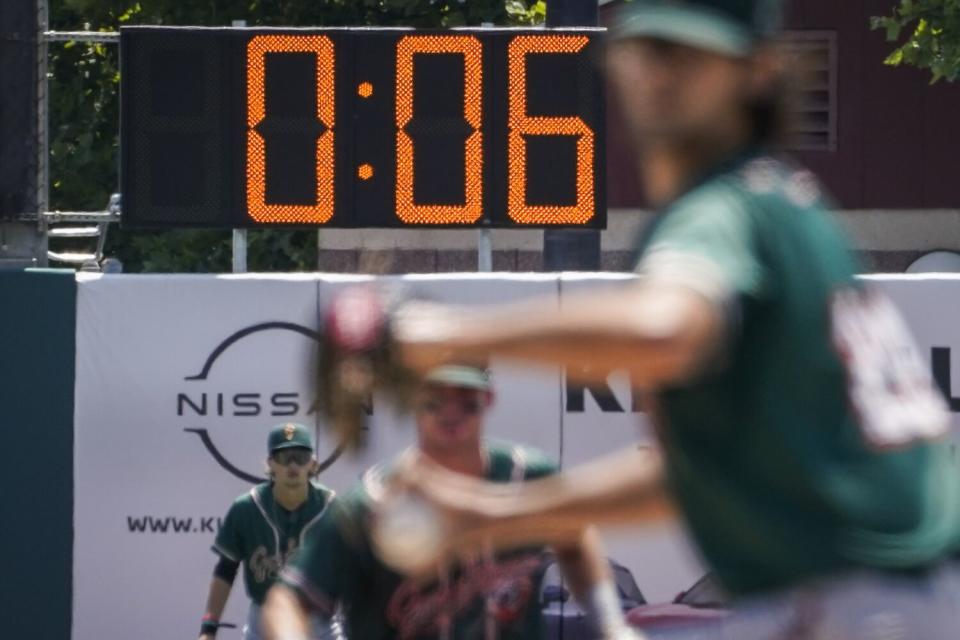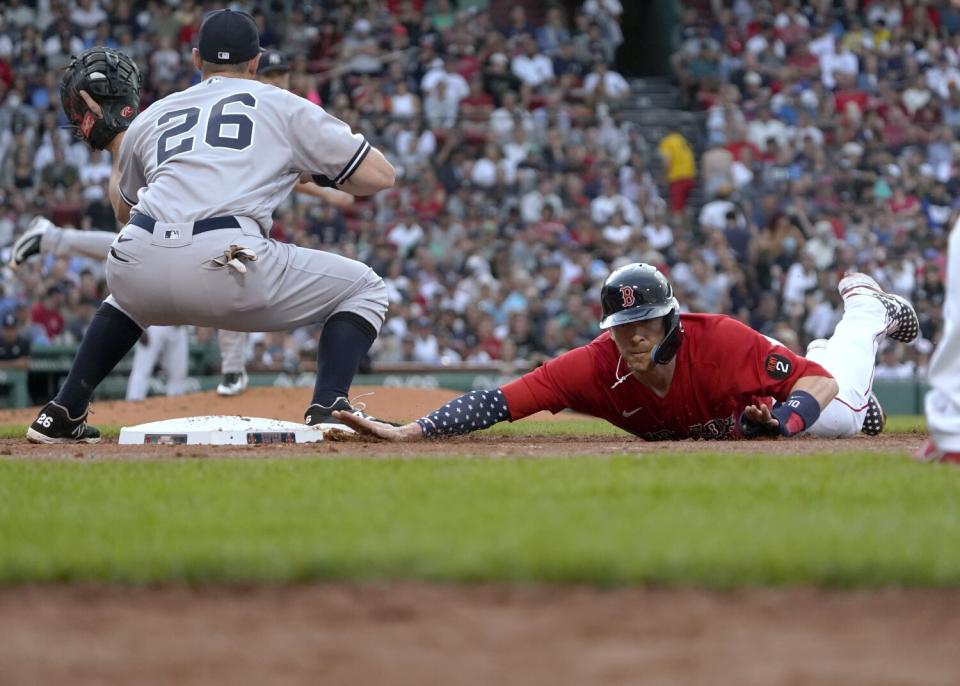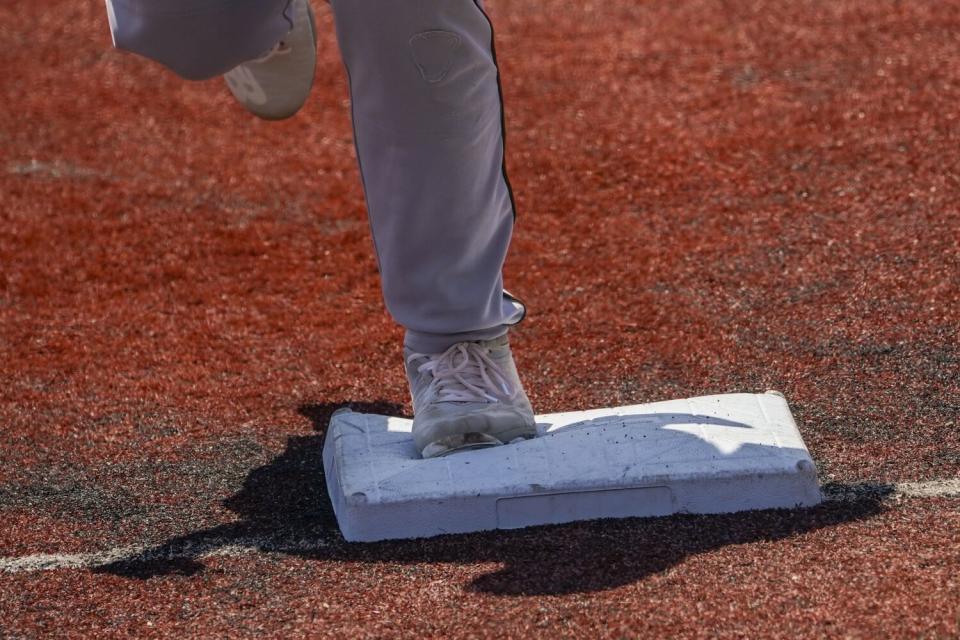How four rule changes will impact Major League Baseball in 2023

Major League Baseball’s hot stove has been all the way turned up over the last two weeks, melting expectations as free agents enjoy the richest market in history. But roster construction is far from complete for most clubs. Two months remain before pitchers and catchers report for spring training. There’s plenty of time for more moves.
Hovering in the backdrop as front offices allocate their resources is an unknown awaiting them until the games start. The 2023 season will introduce perhaps the biggest non-COVID-season wave of rules changes the league has seen. There are four major changes: a pitch timer, a pickoff limit, defensive shift restrictions and bigger bases.
Earlier this month, several managers and front office executives offered their opinions on the upcoming changes at the winter meetings in San Diego. Most of the executives were not authorized to speak publicly about the changes and requested anonymity. They did not expect a huge impact, at least not immediately, but a consensus formed: One change will require more adaptation for players than the rest. Let’s start there as we break down each.
Pitch clock

The pitch clock has been commissioner Rob Manfred’s pet project for years, and for good reason. Games have gotten longer and longer over the last 15 years, reaching an average of three hours in 2012 and never going back under the mark.
Average game length peaked in 2021 when it reached 3:11 before five minutes were shaved off last season. The development didn’t change MLB’s course. In September, the league announced the pitch clock was coming in 2023, upsetting devout purists who detest the idea of a clock dictating action on a baseball field.
But if last season’s implementation across the minor leagues is any indication, the pitch clock should fulfill the league’s mission to quicken games without much of a problem. But people in the industry believe it’ll take time to become acclimated.
“I think the pitch clock is a real thing that people are going to have to adjust to,” Dodgers president of baseball operations Andrew Friedman said. “I think there’s a great unknown of who’s going to be able to and who’s not. For some guys it’s going to be easy, and for others it’s not.”
The minor league version went like this: A 14-second timer between pitches with the bases empty was instituted across all levels. The timer increased to 18 seconds with a runner on base at every level but triple A where it was 19 seconds. There was also a 30-second timer between batters. The penalties were simple: An automatic ball if the pitcher didn’t throw the pitch in time and an automatic strike if the hitter wasn’t ready.
The timers shortened minor league games by 25 minutes last season — from 3 hours, 3 minutes in 2021 to 2 hours, 38 minutes.
“I saw it in Las Vegas [in triple A],” Texas Rangers manager Bruce Bochy said. “I've seen it work, though. It's pretty good. Las Vegas, I don't know if you've ever seen a game there, I think it's like 14-10 and the game was under three hours. It was amazing, the pace.”
MLB’s version in 2023 will be slightly different. There will be a 15-second timer between pitches with the bases empty and a 20-second clock with runners on base. Like the minors, there is a 30-second timer between batters.
“The pitch clock is something that I think the whole league is going to have to go through spring training with some focus,” Colorado Rockies manager Bud Black said. “I think the pitchers will handle it, but the hitters having to be in the box with eight seconds left with the clock starting at 20 or starting with 15, all that time out of the box, fixing gloves and kicking cleats and looking at the third base coach, that's going to speed up on them. Those spring training games will be very, very important.”
Dodgers reliever Alex Vesia was the team’s slowest-paced pitcher last season, according to Baseball Savant. He ranked as the eighth-slowest pitcher with a median of 24.5 seconds between pitch releases, which isn’t exactly how MLB’s timer will work (the timer will start when the pitcher receives the throw from the catcher and end when he starts his delivery).
Left-hander José Suarez was the Angels’ slowest pitcher at 22.1 seconds, ranking 32nd. Former Dodgers closer Kenley Jansen (25.6 seconds) was the third slowest in the majors.
“Pitch clock, I'm thrilled about it,” Tampa Bay Rays manager Kevin Cash said. “Speed the game up. They get too long. If we're playing the Red Sox or playing the Yankees, they turn into four-hour ballgames. I'm not really sure how it impacts our pitchers. They'll figure it out.”
Said one American League executive: “Some players will complain about it at the beginning and then everyone will get used to it and like it. That’s what always happens.”
Pickoff limit

This addition is technically part of the pitch timer rule change, but it’s worth examining separately because of the potential impact.
For the first time, pitchers won’t be allowed to throw over to a base as often as they want. Instead, they’ll be limited to two “disengagements” (pickoff attempts or stepoffs). If a pitcher disengages a third time for a pickoff attempt, the runner advances one base if the attempt fails.
MLB is implementing the rule for two reasons: to speed up the game and to increase stolen base attempts (i.e. action).
The change, two front-office executives each theorized, could create a game-within-a-game between the pitcher and a baserunner.
Do baserunners become more aggressive knowing pitchers could be reluctant to throw over? Does the pitcher throw over a second time, risking reaching the limit? Does the baserunner get more aggressive after the first pickoff attempt? Does he receive the green light after a second failed try?
“The throwovers, that's changing strategy a little bit,” Bochy said. “Stepping off and throwing over a couple times and you're in a box a little bit.”
Zoom out and there’s another possible effect: If the stolen base success rate rises, do front offices, in a blast from the past, add more value to fast players/elite base stealers (which aren’t always synonyms)? Do they seek more base stealers as they piece together a roster?
“That could happen,” one American League executive said. “But I think teams would lag behind the trend because talent pipelines need to adjust. It’d take time before you see a meaningful impact in roster construction.”
All that hinges on whether there’s a significant increase in stolen base attempts, whether it’s in 2023 or beyond.
“When I give the green light, our guys go,” Cash said. “We are known for [the green light]. So, I don't know if I can do it anymore. If I put red light on, they're still going to go.”
Defensive shift restriction

This rule change will be the most obvious to the eye. Drastic infield shifts have become so common across the majors over the last decade that it’s been more noteworthy when an infield doesn’t shift. We’ve seen four outfielders. We’ve seen two outfielders. We’ve seen the third baseman stationed in shallow right field against most left-handed hitters. And we’ve seen San Diego Padres third baseman Manny Machado positioned 200 feet from home plate in right field multiple times.
Anti-shifters contend the trend helped create the three-true-outcome plague (home run, walk or strikeout) that has hindered game action. They also argue it created a disadvantage for left-handed hitters, converting groundballs to the right side and line drives to shallow right field into outs. The anti anti-shifters believe it’s on the hitters to adjust, that the sport goes through cycles.
MLB decided forced change was required after watching the batting average on balls in play (BABIP) drop six points from 2012 to 2022 and strikeouts skyrocket. So, starting next season, the defense must have at least four players on the infield and at least two infielders entirely on either side of second base. The penalty is an automatic ball.
“Left-handed hitters will undoubtedly benefit,” an American League executive said. “But how much? Is that two extra hits a month for Bryce Harper? Five? Does his OPS [on-base-plus-slugging percentage] increase 10 points? Twenty points? It’s tough to project.”
One National League executive pointed to the Pittsburgh Pirates signing first baseman Carlos Santana to a one-year, $6.7-million contract as an example of a club forecasting an effect.
Santana, a switch-hitter, had the same hard-hit rate last season as Mookie Betts but batted .192 with a .692 OPS and a 100 OPS+ (meaning he was a league-average hitter) with 364 plate appearances hitting left-handed. Betts finished with a .269 batting average, .873 OPS and 136 OPS+ (meaning he was 36% better than the average hitter).
“That might one of the best signings, value-wise, of the offseason,” the executive said.
This rule doesn’t eliminate the infield shift; teams are still going to put an infielder up the middle, just to the left of second base, with the second baseman over in the hole against left-handed hitters.
“You'll see the second baseman way over, but you can't go out and get that short line drive to right,” Cleveland Guardians manager Terry Francona said. “I just hope that it doesn't encourage bad hitting. I hope that the unintended consequences don't leak in where guys are really trying to pull now, and you see more strikeouts.”
In regards to roster construction, several managers and executives said range from their middle infielders, especially second basemen, will become more important. Theoretically, teams could become more reluctant to put a bat-first defensive liability at second base.
“As far as the defensive shifting, we want to create a very athletic infield that can cover ground,” Arizona Diamondbacks manager Torey Lovullo said. “I already have asked our guys to go in and prepare themselves from the waist down if you're an infielder because you're going to have to go out and get the job done on a much bigger scale.
“It's going to create a lot more offense. There's going to be a lot of gaps in the defense. We're still going to plug holes the best way we can, but we're only going to do it with two guys.”
Bigger bases

The final significant change is the size of the bases. They will now be 18 inches square, up from 15 inches square, while home plate will remain unchanged. The difference will reduce the distance between the bases by 4.5 inches, which means the famous 90 feet between bases is no more.
This change could also increase stolen base attempt and success rates, but MLB’s primary motivation is to give infielders more room to operate around the bases to avoid collisions.
“The teams that have a little bit more team speed might be more prone to run or pursue that a little bit more aggressively,” Black said.
That would place more of an emphasis on athleticism and, perhaps, a little away from the station-to-station baseball seen most nights in recent years, placing more value on the kinds of players who thrived in previous generations. That would generate more action, which MLB covets. Or the impact could be negligible. We won’t know until the games start.
This story originally appeared in Los Angeles Times.

